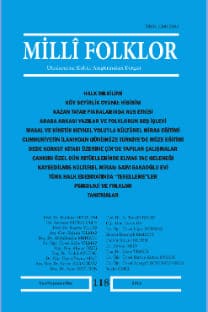Toplumcu gerçekçilik bağlamında Nazım Hikmet'in "Ferhad ile Şirin" oyununa metinlerarası bir bakış
Toplumcu gerçekçilik yazın akımını formülleştiren Maksim Gorki, 1934 yılında Birinci Sovyet Yazarlar Birliği Kongresi’nde yaptığı konuşmada, toplumcu gerçekçi yazarlara folklordan yararlanmalarını önermiştir. Yazarlar, böylece eserleri için gerekli olan malzemeyi folklorda rahatça bulabilecek ve eserlerini olumlu kahraman tipleriyle besleyebilecekti. Bu kongreden sonra Sovyet Komünist Partisi’nin sanat anlayışı olarak belirlenen toplumcu gerçekçilik, Sovyetlerde olduğu gibi Türkiye’de de resim, edebiyat ve sinema gibi birçok sanat dalında eser veren sanatçıyı etkiledi. Bu sanatçılardan biri de Nazım Hikmet Ran’dır. Eserlerinde, folklor ürünlerinden sıkça yararlanan Nazım Hikmet, sözlü gelenekteki halk yapıtlarını, benimsediği siyasal ideoloji olan komünizm ve bu ideolojinin sanattaki yansıması toplumcu gerçekçi yazın akımının ilkelerinden hareketle kendi eserlerinin kurmaca yapısı içerisinde yeniden yorumlamıştır. Bu yorumlarında, halk yapıtlarına, kendi eserlerinde işlediği izlekleri ve bunların anlamlarını yüklemiştir. Yazar, yeniden yaratma/kurma yöntemini kullanarak 1948’de “Ferhad ile Şirin” adlı tiyatro oyununu yazmıştır. Bu oyunun kurmaca yapısı içerisinde, oyunun alt metni olan “Ferhat ile Şirin” halk hikâyesi, yeni bir yöntem, bakış ve anlamla yeniden yazılmıştır. Bu çalışmada, “Ferhat ile Şirin” halk hikâyesi ile Nazım Hikmet’in “Ferhad ile Şirin” tiyatro oyunu arasındaki metinlerarası ilişki incelenecektir. Bu inceleme, toplumcu gerçekçilik bağlamında gerçekleştirilecek ve incelemede Gérard Genette’in metinlerarası ilişkiyi açıklamak için önerdiği “palempsest kuramı” kullanılacaktır.
An Intertextual Approach to Nazım Hikmet’s Play “Ferhad and Şirin” in the Context of the Socialist Realism
In the 1st Soviet Writers Union Congress in 1943, Maksim Gorki who has formulized the socialist realism movement, advised socialist realist writers in his speech to benefit from folklore. So the writers would easily be able to find the material they need for their works in folklore and would be able to feed their works with positive characters. After this congress, the socialist realism which was determined to be the concept of art by the Soviet Communist Party effected many artists who have produced works in several braches of art such as literature, painting and cinema in Turkey just like it did in the Soviets. Nazım Hikmet Ran is one of these artists. Nazım Hikmet who has frequently used products of folklore in his works has interpreted folk places in oral traditional, communism as the political ideology he has adopted and the reflection of this ideology in art in the context of the principles of the socialist realism movement within his own fictional structure in his works. In these interpretations he has installed the themes he uses in his works and their meanings to the folk places. The writer has written the play “Ferhad and Şirin” in 1948 by using the interpretation technique. The play “Ferhad and Şirin” which is a folk story was rewritten with a new technique, point of view and meaning within the fictional structure of the play. In this session, the relationship between the two texts – the play version of “Ferhad and Şirin” written by Nazım Hikmet and the folk story version of “Ferhat and Şirin” – will be analyzed. This analysis will be made in the context of socialist realism into account and in the analysis the “palempsest theory” that was found by Gérard Genette to explain the relationship between two texts will be used.
___
- Aktulum, Kubilay (1999), Metinlerarası İlişkiler, Ankara, Öteki Matbaası
- Moran, Berna (1999), Edebiyat Kuramları ve Eleştiri, İstanbul, İletişim Yayınları
- Oktay, Ahmet (2008), Toplumcu Gerçekçiliğin Kaynakları, İstanbul, İthaki Yayınları
- Özarslan, Metin (2006), Ferhat ile Şirin -Mukayeseli Bir Araştırma-, İstanbul, Doğu Kütüphanesi
- Özay, Yeliz (2007), “Metinlerarası İlişkilerde Türk Halk Hikâyeleri”, Gazi Üniversitesi- Sosyal Bilimler Enstitüsü, Yayınlanmamış Yüksek Lisans Tezi
- Ran, Nazım Hikmet (2002), Ferhad ile Şirin Oyunlar 2, İstanbul, Yapı Kredi Yayınları
- Rifat, Mehmet (2008), Yaklaşımlarıyla Eleştiri Kuramcıları, İstanbul, Sel yayıncılık,
- Sokolov, M. Yuri (2009), Folklor: Tarih ve Kuram, Ankara, Geleneksel Yayıncılık
- Turan, M. İnanç (2004), Nazım’ı Nazımca Anlamak, İzmir, Etki Yayınevi
- ISSN: 1300-3984
- Yayın Aralığı: Yılda 4 Sayı
- Başlangıç: 1989
- Yayıncı: Geleneksel Yayıncılık Eğitim San. Tic. Ltd. Şti.
Sayıdaki Diğer Makaleler
Bir fakelore örneği olarak Çağan Irmak'ın "Takip"i
Akraba olmayan dillerin birbirine etkisi ve bu etkileşimin sonuçları
"Kolsuz hanım" üzerine yazılı kültür ve metinlerarası ilişkiler bağlamında bir çalışma
Bir fakelore örneği olarak Çağan Irmak'ın "Takip"i
Türk kültürüne eleştiri. Umay Türkeş-Günay, Akçağ Yayınları, Ankara, 2009
Dini şahsiyetler hakkında oluşan anlatılar
Metinlerarasılık ve Türk halk hikayelerinde ana-metinsel dönüşümler
Dede Korkut anlatmalarında metinlerarası söylem
Toplumcu gerçekçilik bağlamında Nazım Hikmet'in "Ferhad ile Şirin" oyununa metinlerarası bir bakış
Ağrıdağı Efsanesi'nden sözlü edebiyata "metinlerarası" bir yolculuk
